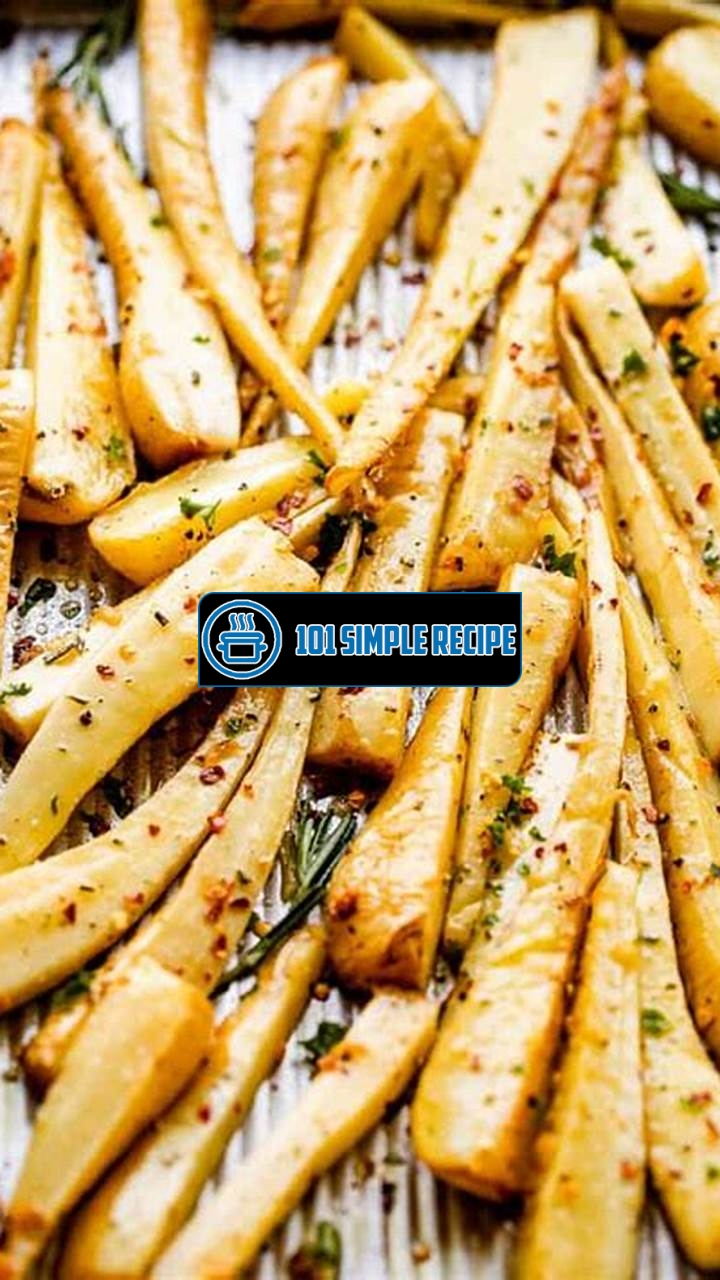If you’re looking for a flavorful and nutritious side dish that will complement any meal, look no further than this delicious pureed roasted parsnips recipe. ✨ Roasted parsnips are a simple yet satisfying dish that brings out the natural sweetness of these root vegetables. By roasting them in the oven until they are soft and caramelized, you’ll unleash a depth of flavor that will have you coming back for seconds. Plus, by pureeing the roasted parsnips, you’ll create a smooth and creamy texture that will melt in your mouth. Whether you’re serving this as a standalone dish or as a base for a savory sauce, this recipe will become a new favorite in your kitchen. So, grab your parsnips and let’s get cooking! ️

Exploring Pureed Roasted Parsnips
Discover the deliciousness and versatility of pureed roasted parsnips and learn how to make them at home. With their rich flavor and smooth texture, pureed roasted parsnips make a delightful addition to any meal. Whether you’re looking for a tasty side dish or a unique ingredient to incorporate into your favorite recipes, these savory root vegetables are sure to impress.
The Flavors of Roasted Parsnips
The flavor profile of roasted parsnips is truly something special. When cooked, parsnips take on a slightly sweet and nutty taste with a hint of earthiness. This unique combination of flavors makes them an excellent choice for pureeing. The roasting process caramelizes the natural sugars in the parsnips, enhancing their sweetness and adding a depth of flavor, while also creating a slightly crispy texture on the outside. Once pureed, the roasted parsnips develop a creamy consistency that is velvety smooth and incredibly satisfying. ️
One of the key benefits of using pureed roasted parsnips in your cooking is their ability to enhance the overall taste of a dish. Whether you’re making a rich and savory soup, a creamy mashed potato substitute, or a flavorful sauce to accompany your favorite protein, adding pureed roasted parsnips will take your culinary creations to the next level. Their unique flavor profile complements a wide range of ingredients and can add depth and complexity to even the simplest of recipes.
Parsnips: A Nutritional Powerhouse
Besides being a delicious addition to your meals, pureed roasted parsnips also offer a multitude of health benefits. These root vegetables are packed with essential vitamins and minerals, making them a nutritious choice for any diet.
Parsnips are an excellent source of dietary fiber, which aids in digestion and promotes a healthy gut. They are also rich in vitamin C, which supports immune function and collagen production, and vitamin K, which plays a vital role in bone health. Additionally, parsnips contain significant levels of folate, potassium, and manganese, all of which contribute to overall wellbeing.
Including pureed roasted parsnips in your diet can help increase your vegetable intake and provide a range of important nutrients. They can be a particularly valuable addition for those following a vegan or vegetarian diet, as they offer a hearty and satisfying alternative to meat-based dishes.
Choosing and Preparing the Perfect Parsnips
When selecting parsnips for your pureed roasted parsnips recipe, look for ones that are firm and free from blemishes. The smaller, young parsnips tend to be sweeter and more tender. Avoid parsnips that are overly large or have a woody texture, as they can be tough and fibrous.
Before roasting, it’s important to thoroughly wash and peel the parsnips to remove any dirt or remaining skin. Once cleaned, cut them into even-sized pieces to ensure they cook evenly. Toss the parsnips with olive oil, salt, and pepper for basic seasoning, or get creative and experiment with different herbs and spices to add additional depth of flavor.
Roast the parsnips in a preheated oven at 425°F (220°C) for approximately 25-30 minutes, or until they are golden brown and tender. Remember to turn them occasionally during cooking to ensure they roast evenly. ️ Once roasted, allow them to cool slightly before pureeing them in a food processor or blender until smooth and creamy.
Now that you’ve learned about the delightful flavors of pureed roasted parsnips and how to choose and prepare them, you’re ready to embark on a culinary adventure in your own kitchen. So why wait? Start experimenting with this versatile ingredient and let your taste buds explore the wonders of pureed roasted parsnips.
If you’re trying to watch your weight, here’s a weight loss recipe that’s both healthy and tasty. It’s a great option for those on a weight loss journey.
Roasting Parsnips to Perfection
Master the art of roasting parsnips to bring out their natural sweetness and enhance their texture.
The Right Technique for Roasting
Roasting parsnips is a simple yet effective way to bring out their unique flavor and create a delicious side dish or addition to hearty meals. Follow these steps to achieve perfectly roasted parsnips:
- Preheat your oven to 425°F (220°C) to ensure a hot and even cooking environment for the parsnips.
- Start by peeling and trimming the parsnips. Make sure to remove any tough or woody parts, as they can affect the overall texture.
- Cut the parsnips into even-sized pieces, around 2-3 inches long. Keeping them uniform in size will help them cook evenly.
- Place the parsnips on a baking sheet and drizzle them with a generous amount of olive oil. Use your hands or a brush to evenly coat each piece.
- Season the parsnips with salt and pepper to taste. You can also experiment with other herbs and spices such as rosemary, thyme, or garlic powder to add extra flavor.
- Spread the parsnips out in a single layer, making sure they have enough space to brown and crisp up evenly.
- Roast the parsnips in the preheated oven for about 25-30 minutes, or until they are golden brown and tender. Flip them halfway through the cooking time to ensure even browning on all sides.
Pro Tip: To achieve a caramelized and slightly crisp exterior, increase the oven temperature to 450°F (230°C) for the last 5-10 minutes of cooking.
Seasoning and Flavor Combinations
While roasted parsnips are delicious on their own, you can elevate their flavor profile by experimenting with different seasonings and flavor combinations. Here are a few ideas to get you started:
- Maple-Sage Glaze: Combine maple syrup, chopped fresh sage, and a touch of Dijon mustard. Brush the mixture onto the parsnips before roasting for a sweet and savory twist.
- Balsamic-Roasted: Toss the parsnips in balsamic vinegar, olive oil, honey, and a sprinkle of thyme. The tanginess of the balsamic complements the sweetness of the parsnips beautifully.
- Indian Spice Blend: Mix together ground cumin, coriander, turmeric, and a pinch of cayenne pepper. Coat the parsnips in the spice blend and roast them for a flavorful and aromatic dish.
- Garlic and Parmesan: Mince a few cloves of garlic and combine them with grated Parmesan cheese. Toss the parsnips in the mixture before roasting for a cheesy, garlicky delight.
Flavor Inspiration: Don’t be afraid to experiment with different herbs, spices, and sauces to create your own unique flavor combinations that suit your taste preferences.
Troubleshooting Roasting Issues
Roasting parsnips is generally a straightforward process, but sometimes unexpected issues may arise. Here are a few troubleshooting tips to overcome common roasting challenges:
- Soft and Mushy Parsnips: If your parsnips turn out soft and mushy instead of crispy and tender, it is likely because they were overcrowded on the baking sheet. Make sure to give them enough space to allow for proper caramelization.
- Burnt Edges: If the edges of your parsnips become burnt while the centers remain undercooked, try lowering the oven temperature slightly or reducing the cooking time. You can also cover the baking sheet loosely with aluminum foil to prevent burning.
- Inconsistent Browning: If your parsnips are browning unevenly, make sure to flip them halfway through the cooking time. Additionally, check if your oven has any hot spots and adjust the positioning of the baking sheet accordingly.
- Lack of Flavor: If your roasted parsnips lack flavor, it may be because you didn’t season them adequately. Be generous with your salt, pepper, and any additional spices or herbs you choose to use.
Keep in mind: Every oven is different, so don’t be afraid to make adjustments to the cooking time and temperature based on your specific appliance’s performance.
The Magic of Pureeing
Unleash the velvety smoothness of pureed parsnips and discover the creative uses for this versatile ingredient. Pureeing parsnips brings out their natural sweetness and silky texture, making them a delectable addition to any dish.
Pureeing is a culinary technique that involves blending or mashing ingredients into a smooth, homogeneous texture. In the case of parsnips, this process transforms the root vegetable into a heavenly puree that can be used in various ways.
One of the magical qualities of pureeing parsnips is the ability to create a luxurious and creamy consistency. The starchy nature of parsnips allows them to thicken when pureed, resulting in a velvety smooth texture that effortlessly melts in your mouth. The silky mouthfeel adds a touch of elegance to any dish, elevating it to a whole new level of culinary delight.
Additionally, pureeing parsnips opens up a world of creative possibilities. You can use the puree as a base for soups, sauces, and even desserts. Its mild flavor pairs well with various herbs and spices, allowing you to experiment with different combinations and create unique taste profiles.
The Perfect Puree: Tips and Techniques
Creating the perfect parsnip puree requires a few tips and techniques to achieve that irresistibly smooth consistency and enhance the flavor.
- Choose the right parsnips: Opt for parsnips that are firm and plump, with a creamy white color and no signs of blemishes or soft spots. Fresh parsnips yield the best results when pureed.
- Properly peel and chop: Peel the outer skin of the parsnips using a vegetable peeler or a sharp knife. Make sure to remove any woody cores or tough parts. Chop the parsnips into uniform pieces to ensure even cooking and easy pureeing.
- Roasting for enhanced flavor: Before pureeing, consider roasting the parsnips to bring out their natural sweetness and add a depth of flavor. Simply toss the chopped parsnips with olive oil, salt, and pepper, then roast them in an oven until they become tender and slightly caramelized.
- Blending to perfection: Use a high-powered blender, food processor, or immersion blender to puree the roasted parsnips. Start on a low setting and gradually increase the speed until you achieve a smooth and creamy consistency. For a finer texture, pass the puree through a fine-mesh sieve.
- Seasoning and balancing flavors: Taste the puree and adjust the seasoning accordingly. Add salt, pepper, herbs, or spices to enhance the flavors. Consider adding a touch of sweetness like honey or maple syrup for a delightful contrast.
Enhancing Flavor and Texture in Pureed Parsnips
To take your pureed parsnips to the next level, you can enhance their flavor and texture by incorporating a few creative ingredients and techniques.
1. Creamy additions: Add a dollop of cream, sour cream, or Greek yogurt to the pureed parsnips for an extra creamy texture and a hint of tanginess. These dairy products blend seamlessly with the parsnips, enhancing their richness and adding a velvety touch.
2. Aromatic herbs and spices: Experiment with different herbs and spices to elevate the flavor profile of your pureed parsnips. Consider adding fresh thyme, rosemary, or nutmeg for a savory twist. Dried spices like cumin or paprika can also bring a warm and earthy note to the puree.
3. Flavored oils: Drizzle a flavored oil, such as truffle oil or herb-infused oil, over the pureed parsnips to add an extra layer of complexity. The subtle aromas of these oils enhance the overall taste and make the dish even more sophisticated.
4. Texture contrast: To add a delightful crunch and visual appeal, top your pureed parsnips with toasted breadcrumbs, chopped nuts, or crispy bacon. These crunchy elements provide a pleasant contrast to the smoothness of the puree and add an interesting texture to each bite.
Incorporating Pureed Parsnips into Your Cooking
Pureed parsnips can be incorporated into a wide range of dishes, complementing both sweet and savory preparations. Here are some creative ideas for incorporating this versatile ingredient into your cooking:
1. Soups and sauces: Use the parsnip puree as a base for creamy soups, such as parsnip and pear soup or parsnip and leek soup. You can also incorporate it into sauces for pasta, meat, or fish dishes to add a luscious and velvety texture.
2. Mashed potato upgrade: Mix the parsnip puree with mashed potatoes for a flavorful twist on the classic side dish. The combination of potatoes and parsnips creates a creamy and subtly sweet mash that pairs well with roasted meats or grilled vegetables.
3. Baked goods: Get adventurous and incorporate pureed parsnips into baked goods, such as bread, cakes, or muffins. The parsnips add moisture and a unique flavor profile to these treats, making them moist and irresistible.
4. Vegetable side dishes: Serve the pureed parsnips as a standalone vegetable side dish or use it as a sauce to accompany roasted vegetables, such as carrots, Brussels sprouts, or cauliflower. The silky smoothness of the puree complements the roasted flavors and adds a touch of elegance to the dish.
Explore the magic of pureed parsnips and unleash your culinary creativity. With its velvety smoothness and versatile nature, this ingredient will elevate your dishes to new heights of deliciousness.
Recipes Featuring Pureed Roasted Parsnips
Get inspired with a collection of flavorful recipes that showcase the unique qualities of pureed roasted parsnips. These recipes are perfect for those looking to add a delicious twist to their meals.
Velvety Pureed Parsnips with Herbed Butter
Indulge in the rich and creamy flavors of velvety pureed parsnips with herbed butter. This recipe takes the humble parsnip to a whole new level. The parsnips are roasted to perfection, then blended to a smooth consistency. The addition of herbed butter adds a burst of freshness and enhances the overall flavor. This dish is a great option for a comforting side dish or a light lunch.
- Step 1: Preheat the oven to 400°F (200°C) and line a baking sheet with parchment paper.
- Step 2: Peel and chop the parsnips into small pieces.
- Step 3: Toss the parsnips with olive oil, salt, and pepper, then spread them evenly on the prepared baking sheet.
- Step 4: Roast the parsnips for 25-30 minutes, or until they are golden brown and tender.
- Step 5: Transfer the roasted parsnips to a blender and add the herbed butter.
- Step 6: Blend until smooth and creamy.
- Step 7: Serve the velvety pureed parsnips with herbed butter as a side dish or a light lunch.
Enjoy the velvety smoothness of the pureed parsnips combined with the freshness of the herbed butter. This dish is sure to delight your taste buds!
Roasted Parsnip Soup with Spiced Croutons
Warm up on a chilly day with a bowl of roasted parsnip soup topped with spiced croutons. This hearty soup is packed with flavors that will satisfy any craving.
- Step 1: Preheat the oven to 375°F (190°C) and line a baking sheet with parchment paper.
- Step 2: Peel and chop the parsnips into chunks.
- Step 3: Toss the parsnips with olive oil, salt, and pepper, then spread them on the prepared baking sheet.
- Step 4: Roast the parsnips for 30-35 minutes, or until they are tender and caramelized.
- Step 5: In a large pot, melt butter over medium heat. Add diced onions and cook until they are soft and translucent.
- Step 6: Add the roasted parsnips to the pot and stir well.
- Step 7: Pour in vegetable broth and bring the mixture to a boil. Reduce the heat and simmer for 20 minutes.
- Step 8: Use an immersion blender to puree the soup until smooth and creamy.
- Step 9: To make the spiced croutons, toss bread cubes with melted butter, paprika, garlic powder, and salt. Bake in the oven until crispy.
- Step 10: Serve the roasted parsnip soup in bowls and sprinkle the spiced croutons on top.
The combination of the roasted parsnips and the spiced croutons creates a symphony of flavors and textures in every spoonful. This soup is a true comfort food. Enjoy!
Decadent Parmesan Parsnip Mash
Elevate your mashed potato game with this decadent parmesan parsnip mash. The unique flavors of parsnips and parmesan cheese come together in this dish to create a delightful side dish.
- Step 1: Peel and chop parsnips into small pieces.
- Step 2: Place the parsnips in a large pot of boiling water and cook until they are soft and tender.
- Step 3: Drain the parsnips and return them to the pot.
- Step 4: Add butter, parmesan cheese, and a splash of milk to the pot.
- Step 5: Mash the parsnips using a potato masher until they reach your desired consistency.
- Step 6: Season with salt and pepper to taste.
- Step 7: Serve the decadent parmesan parsnip mash as a side dish with your favorite protein.
This parmesan parsnip mash is rich, creamy, and full of flavor. The parsnips add a unique sweetness that pairs perfectly with the sharpness of the parmesan cheese. It’s a side dish that will impress your guests!
If you’re looking for more delicious recipes, check out this White Castle recipe. It’s an iconic fast food dish that you can easily make at home.
Troubleshooting and FAQs
In this section, we will address common concerns and questions about pureed roasted parsnips to ensure a successful cooking experience. Whether you’re a novice in the kitchen or an experienced cook, understanding these troubleshooting tips and frequently asked questions will help you perfect your pureed roasted parsnips recipe.
Why are my parsnips turning out mushy?
If your parsnips are turning out mushy, there could be a few reasons behind it. One common mistake is overcooking the parsnips. Parsnips should be tender but still hold their shape. To avoid mushy parsnips, make sure to check for doneness frequently while roasting. Additionally, using too much water when pureeing the roasted parsnips can also result in a mushy texture. Start with a smaller amount of liquid and gradually add more as needed to achieve the desired consistency.
Another potential cause for mushy parsnips is using old or spoiled parsnips. Make sure to choose fresh parsnips that are firm and without any signs of decay. Older parsnips tend to become softer and less flavorful, which can affect the final texture of your puree.
How can I make my pureed parsnips creamier?
If you prefer a creamier texture for your pureed parsnips, there are a few techniques you can try. First, consider adding a touch of cream or milk to the mixture before pureeing. This will help to create a smoother and silkier consistency. You can also experiment with different types of fats, such as butter or olive oil, for added richness.
Another way to achieve a creamier puree is by using a food processor or blender instead of a traditional masher. This will help break down the parsnips more thoroughly, resulting in a smoother texture. Be sure not to overprocess, as this can lead to a gluey texture rather than creamy.
Can I freeze pureed roasted parsnips?
Absolutely! Freezing pureed roasted parsnips is a great way to save time and ensure you always have a comforting side dish on hand. To freeze, allow the puree to cool completely before transferring it into airtight containers or freezer bags. Label the containers with the date and freeze for up to three months.
When thawing, simply place the container in the refrigerator overnight. Alternatively, you can thaw it in the microwave using the defrost setting. Once thawed, gently reheat the puree on the stovetop or in the microwave, adding a splash of liquid if necessary to reach the desired consistency.
It’s important to note that while the flavor of the pureed parsnips may not be significantly affected by freezing, the texture may change slightly. However, with proper reheating techniques, you can still enjoy delicious and creamy pureed parsnips even after freezing.
Embrace the deliciousness of pureed roasted parsnips and use these troubleshooting tips and answers to frequently asked questions to enhance your cooking skills. Whether you’re aiming for the perfect texture or exploring different storage options, you can confidently create a delectable dish that everyone will love.
If you’re hosting a party and need a refreshing beverage, try this punch bowl recipe. It’s a crowd-pleaser that will impress your guests.
Thank you for taking the time to read our article on the pureed roasted parsnips recipe. We hope you found it both informative and inspiring for your next culinary adventure. If you’re looking for more delicious recipes and cooking tips, be sure to visit our website again in the future. Happy cooking and enjoy your flavorful pureed roasted parsnips! ️
Frequently Asked Questions
Here are some common questions about the pureed roasted parsnips recipe:
| No. | Questions | Answers |
|---|---|---|
| 1. | Can I use other vegetables instead of parsnips? | Absolutely! While parsnips are the star of this recipe, you can experiment with other root vegetables like carrots or sweet potatoes to create your own unique puree. |
| 2. | Can I freeze the pureed roasted parsnips? | Yes, you can! Once the puree has cooled down, transfer it into freezer-safe containers or bags and store them in the freezer for up to three months. Just make sure to thaw it thoroughly before reheating. |
| 3. | Can I add spices to the recipe? | Absolutely! Feel free to add your favorite spices like garlic powder, paprika, or even a pinch of cayenne pepper to give the puree an extra kick of flavor. |
| 4. | How can I make the puree smoother? | For an extra smooth texture, you can pass the roasted parsnips through a fine mesh sieve or use a blender or food processor to achieve the desired consistency. |
| 5. | What can I serve with pureed roasted parsnips? | Pureed roasted parsnips make a fantastic side dish for poultry, pork, or beef dishes. You can also use it as a base for soups or as a flavorful alternative to mashed potatoes. The possibilities are endless! |
| 6. | Can I add cream or butter to the puree? | Absolutely! If you prefer a richer and creamier puree, feel free to add a splash of cream or a knob of butter while blending the roasted parsnips. |
Closing Thoughts
We hope this pureed roasted parsnips recipe has inspired you to try something new in the kitchen. With its earthy flavors and creamy texture, it’s a delicious and healthy option that can elevate any meal. Remember to experiment with different spices and other root vegetables to create your own twist on this recipe. Whether you’re serving it as a side dish or using it as a base for soups, we’re confident you’ll enjoy the delightful flavors of pureed roasted parsnips. Thank you for reading and we look forward to sharing more exciting recipes with you in the future!
Jump to Recipe
Pureed Roasted Parsnips Recipe

Learn how to make a delicious and creamy pureed roasted parsnips that will elevate your meals. This easy-to-follow recipe is bursting with earthy flavors and can be served as a side dish or used as a base for soups.
- 2 lbs parsnips
- 2 tbsp olive oil
- 1 tsp salt
- 1/2 tsp black pepper
- 1/2 tsp dried thyme
- Preheat your oven to 400°F (200°C).
- Peel and chop the parsnips into small pieces.
- Place the parsnips on a baking sheet, drizzle with olive oil, and season with salt, black pepper, and dried thyme. Toss to coat the parsnips evenly. Roast in the preheated oven for 25-30 minutes, or until they are tender and slightly caramelized.
- Transfer the roasted parsnips to a blender or food processor. Blend until smooth and creamy. You can add a splash of cream or a knob of butter for a richer puree, if desired.
- Serve the pureed roasted parsnips as a side dish or use as a base for soups. Enjoy the creamy and flavorful goodness!






